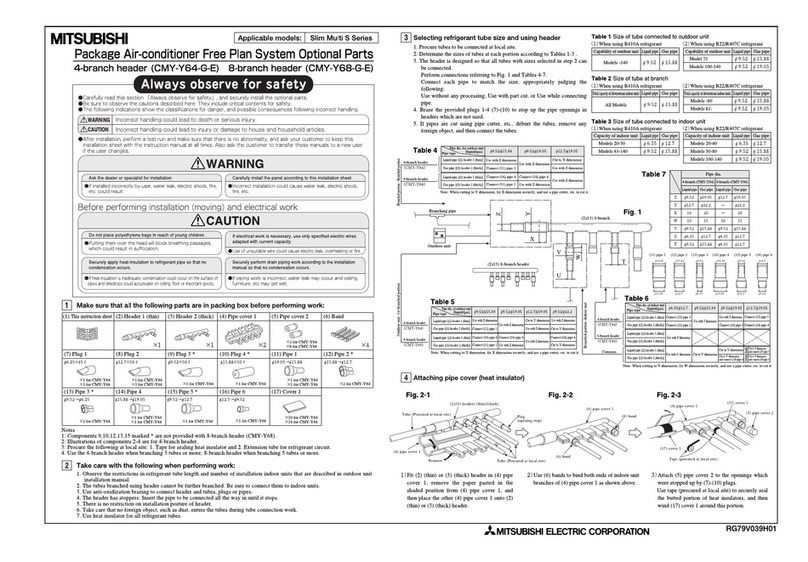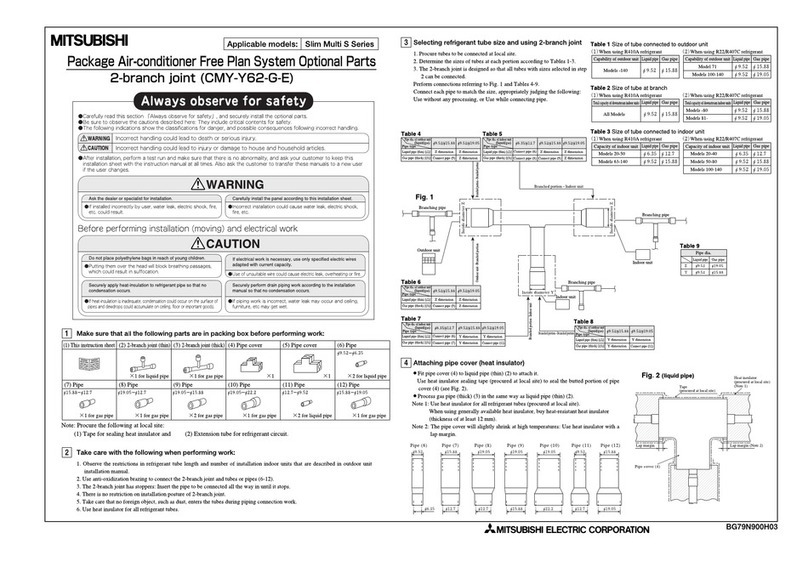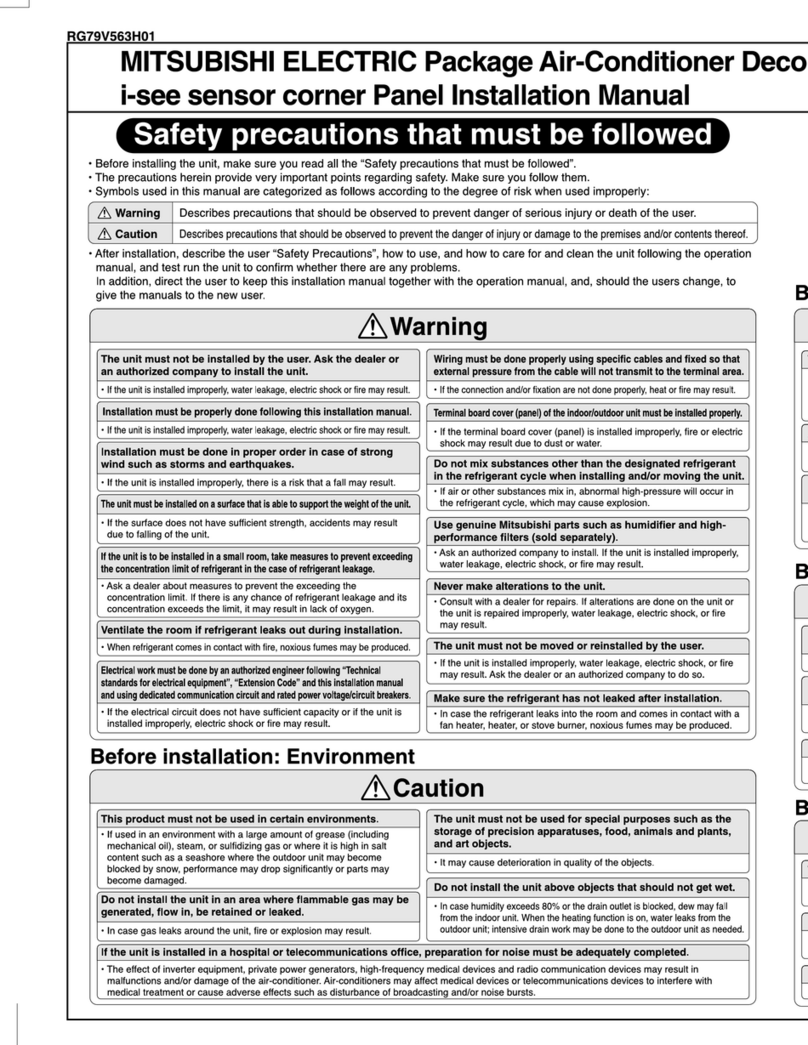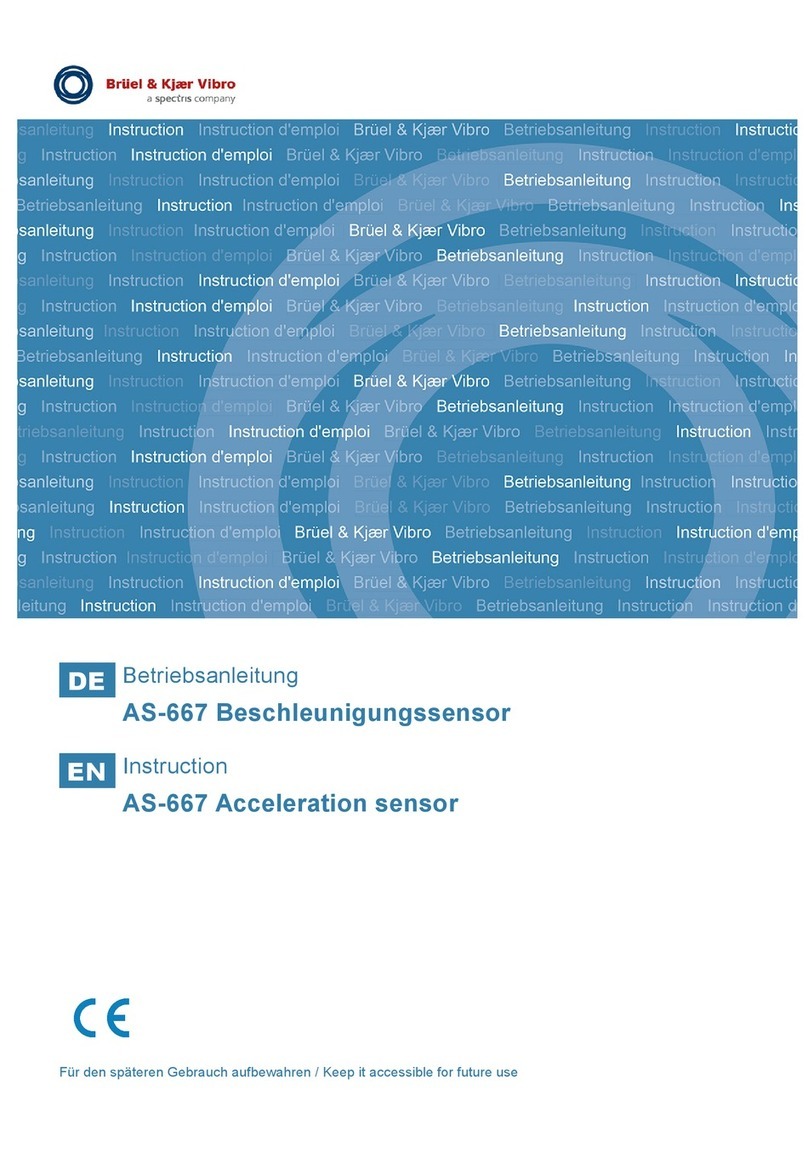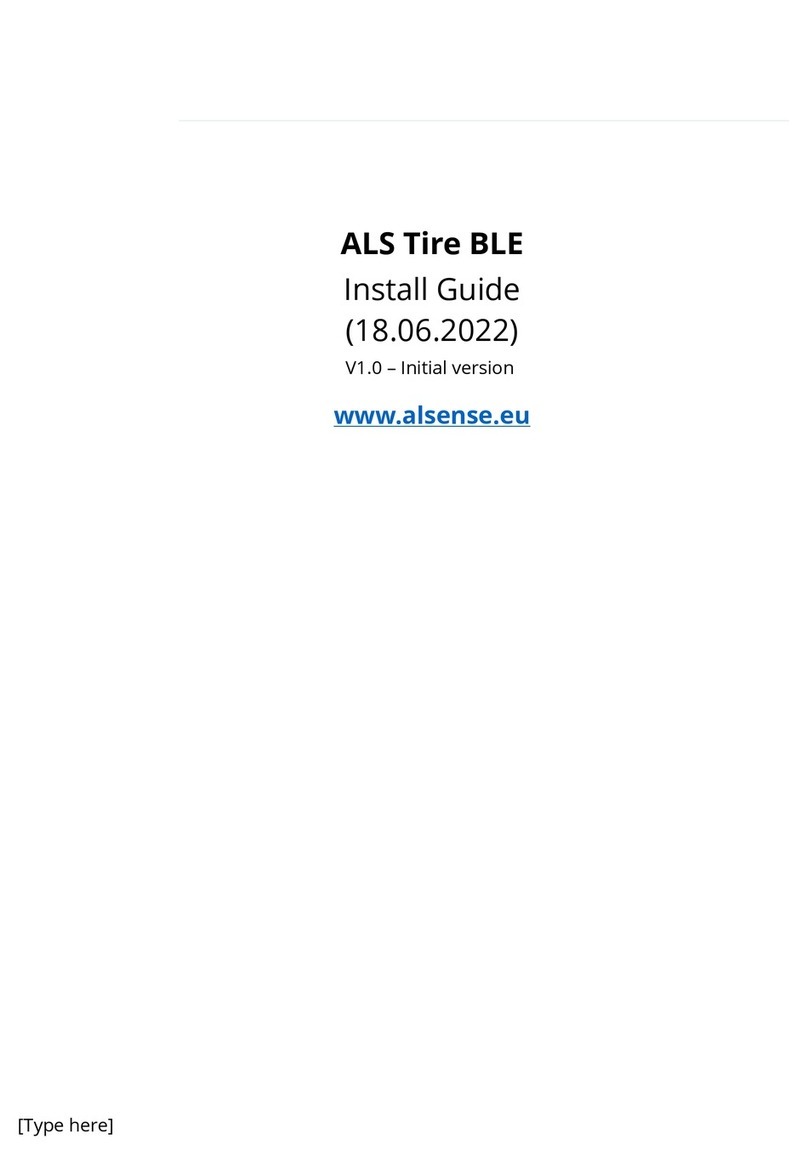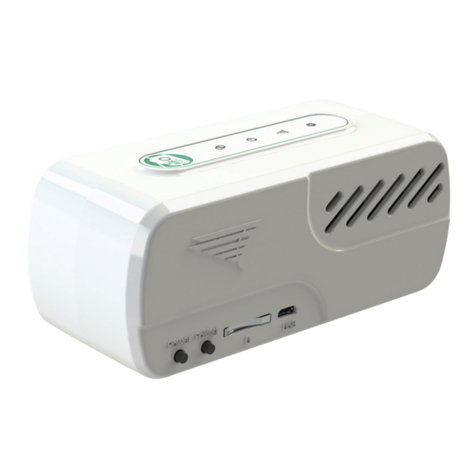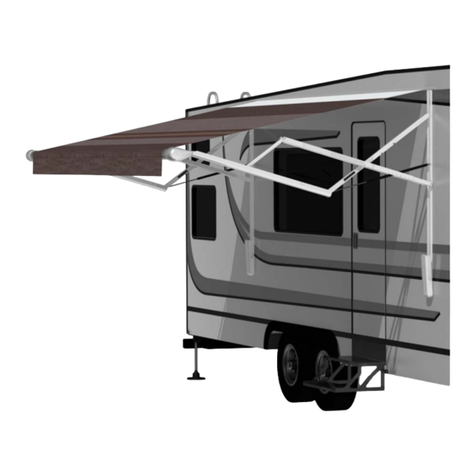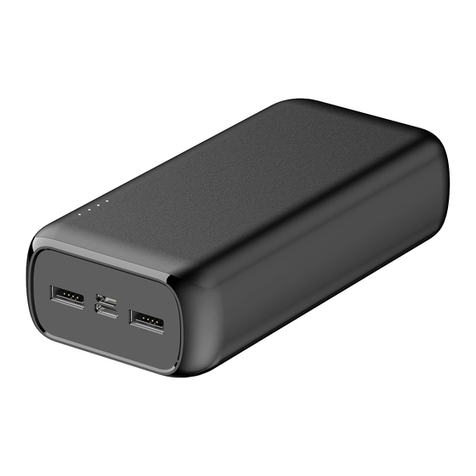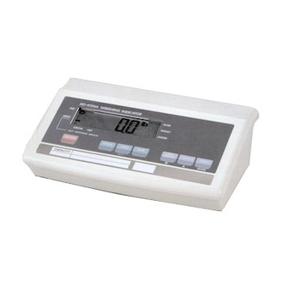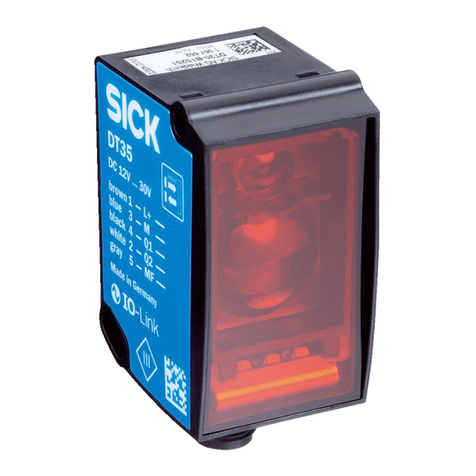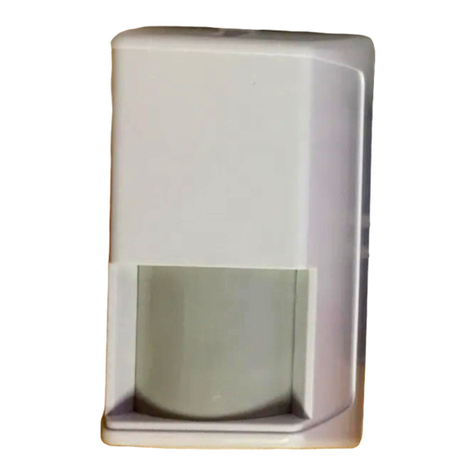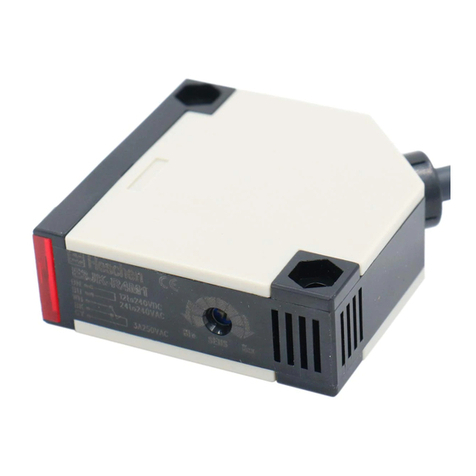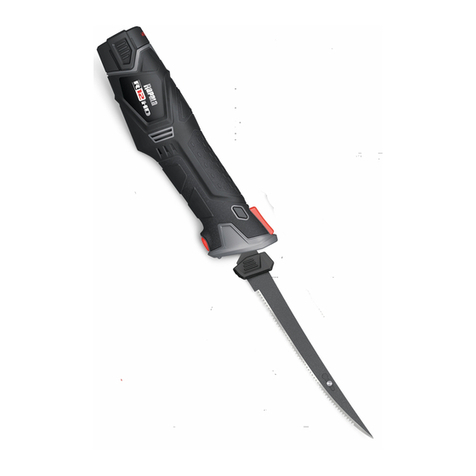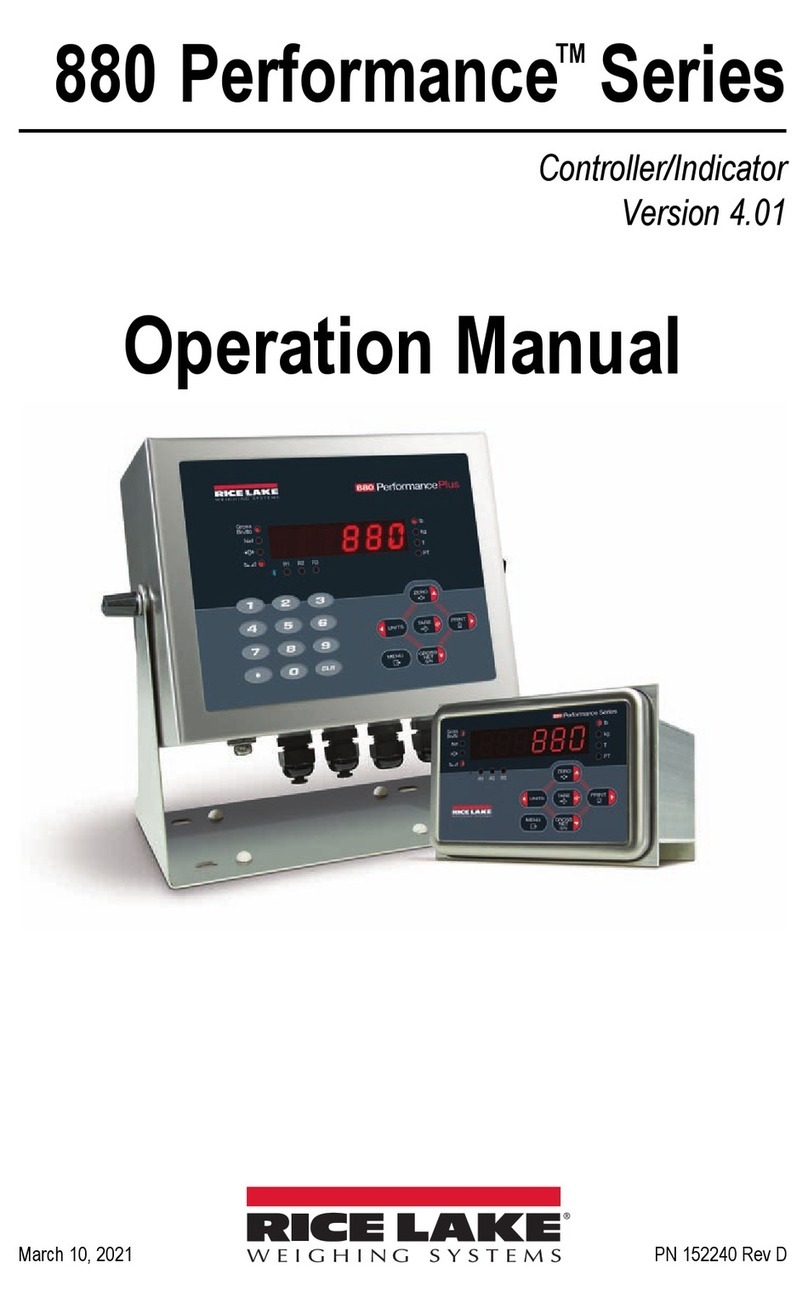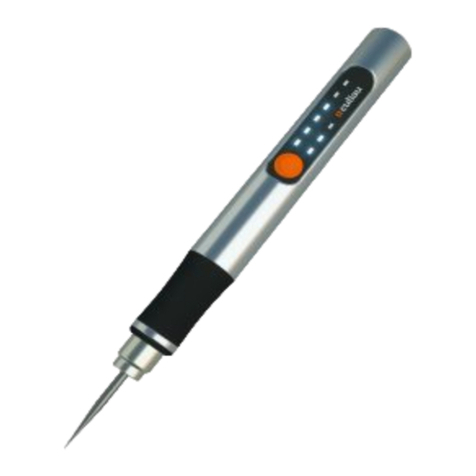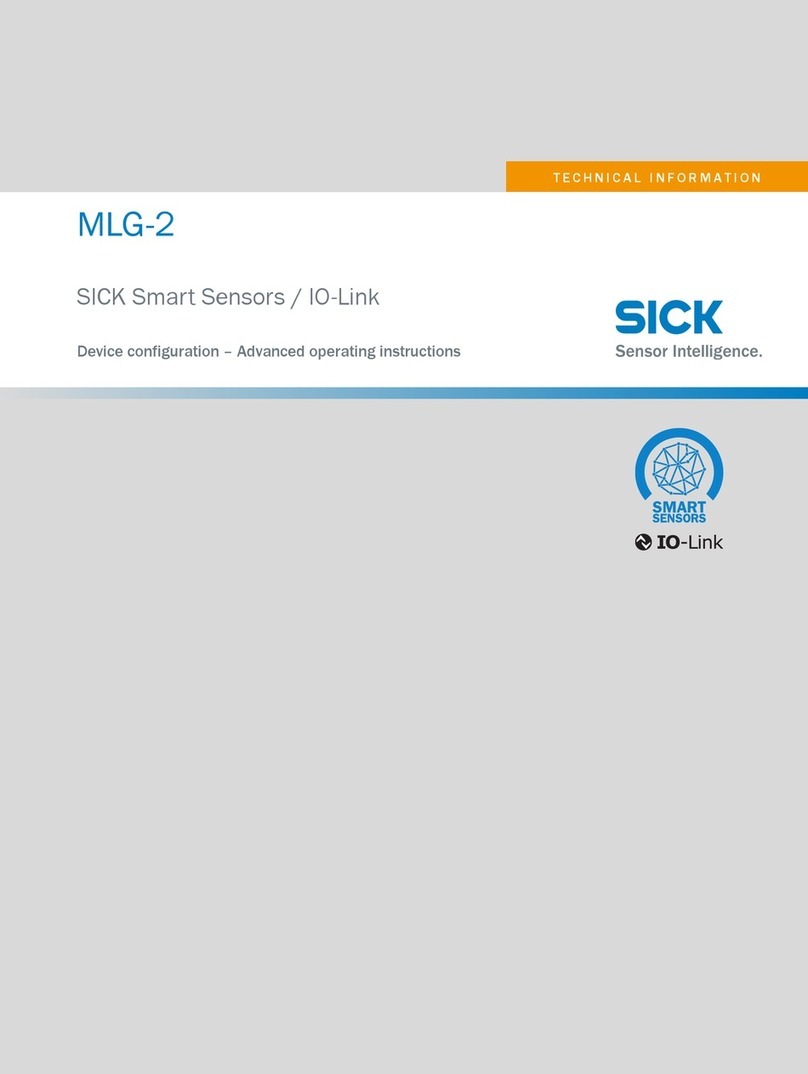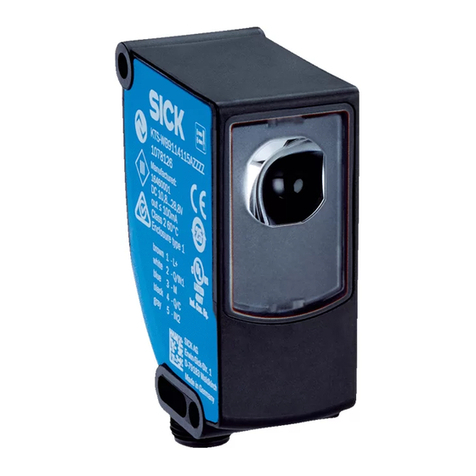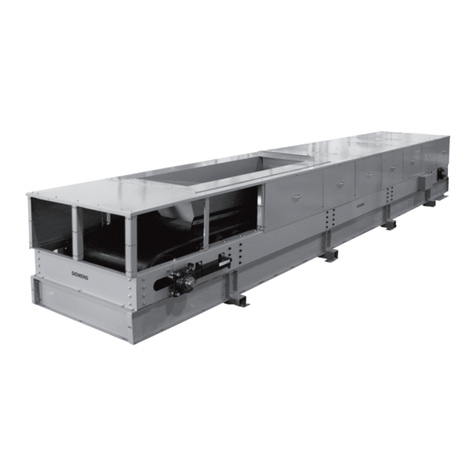Mitsubishi MELFA 4D-2CG5100-PKG-E User manual

Mitsubishi Industrial Robot
CRn-500 Series
Network Vision Sensor Instruction Manual
4D-2CG5100-PKG-E
4D-2CG5400-PKG-E
4D-2CG5401-PKG-E
4D-2CG5403-PKG-E
4D-2CG5400C-PKG-E
4D-2CG5400R-PKG-E
BFP-A8520-*



■ Revision History
Printing Date Instruction Manual No. Revision Contents
2006-10-02 BFP-A8520-* First Edition

■Preface
Thank you for purchasing this network vision sensor for CRn-500 series Mitsubishi Electric industrial robots.
The network vision sensor is an option that is used in combination with a CRn-500 series controller to make it
possible to detect and inspect work through visual recognition. Before using this sensor, please read this
manual well so that you utilize the contents of this manual when using this network vision sensor.
This manual attempts to cover special handling as well. Please interpret the absence of an operation from
this manual as meaning that it can not be done.
The contents of this manual target the following software versions.
Robot controller : Ver. K6 or later
■Symbols & Notation Method in This Manual
・ No part of this manual may be reproduced by any means or in any form,without prior consent from
Mitsubishi.
・ The details of this manual are subject to change without notice.
・
A
n effort has been made to make full descriptions in this manual.However,if any discrepancies or
unclear points are found,please contact your dealer.
・ The information contained in this document has been written to be accurate as much as
possible.Please interpret that items not described in this document “cannot be perfomed.”.
Please contact your nearest dealer if you find any doubtful,wrong or skipped point.
・ Microsoft, Windows, and .NET Framework are registered trademarks of the Microsoft Corporation o
f
the United States in the United States and/or other countries.
・ In-Sight is registered trademark of the Cognex Corporation.
・ Adobe,the Adobe logo,Acrobat,and the Acrobat logo are trademarks of Adobe Systems incorporated.
・ Reference to registered trademarks and trademarks are omitted in this manual.
Copyright(C)2006MITSUBISHIELECTRICCORPORATION ALL RIGHTS RESERVED
CAUTION
WARNING
DANGER
This indicates a situation in which a mistake in handling will expose the
user to the danger of death or severe injury.
This indicates a situation in which a mistake in handling has the
possibility of resulting in death or severe injury of the user.
This indicates a situation in which a mistake in handling has the danger of
causing injury to the user. Equipment damage is also possible.

All teaching work must be carried out by an operator who has received special training. (This also
applies to maintenance work with the power source turned ON.)
Enforcement of safety training
For teaching work, prepare a work plan related to the methods and procedures of operating the
robot, and to the measures to be taken when an error occurs or when restarting. Carry out work
following this plan. (This also applies to maintenance work with the power source turned ON.)
Preparation of work plan
Prepare a device that allows operation to be stopped immediately during teaching work. (This also
applies to maintenance work with the power source turned ON.)
Setting of emergency stop switch
During teaching work, place a sign indicating that teaching work is in progress on the start switch,
etc. (This also applies to maintenance work with the power source turned ON.)
Indication of teaching work in progress
Provide a fence or enclosure during operation to prevent contact of the operator and robot.
Installation of safety fence
Establish a set signaling method to the related operators for starting work, and follow this method.
Signaling of operation start
As a principle turn the power OFF during maintenance work. Place a sign indicating that
maintenance work is in progress on the start switch, etc.
Indication of maintenance work in progress
Before starting work, inspect the robot, emergency stop switch and other related devices, etc.,
and confirm that there are no errors.
Inspection before starting work
A
lways read the following precautions and the separate
"Safety Manual" before starting use of the robot to learn the
required measures to be taken.
Safety Precautions
CAUTION
WARNING
CAUTION
WARNING
CAUTION
CAUTION
CAUTION
CAUTION

The points of the precautions given in the separate "Safety Manual" are given below.
Refer to the actual "Safety Manual" for details.
Use the robot within the environment given in the specifications. Failure to do so could lead to a
drop or reliability or faults. (Temperature, humidity, atmosphere, noise environment, etc.)
Transport the robot with the designated transportation posture. Transporting the robot in a
non-designated posture could lead to personal injuries or faults from dropping.
Always use the robot installed on a secure table. Use in an instable posture could lead to
positional deviation and vibration.
Wire the cable as far away from noise sources as possible. If placed near a noise source,
positional deviation or malfunction could occur.
Do not apply excessive force on the connector or excessively bend the cable. Failure to observe
this could lead to contact defects or wire breakage.
Make sure that the workpiece weight, including the hand, does not exceed the rated load or
tolerable torque. Exceeding these values could lead to alarms or faults.
Securely install the hand and tool, and securely grasp the workpiece. Failure to observe this could
lead to personal injuries or damage if the object comes off or flies off during operation.
Securely ground the robot and controller. Failure to observe this could lead to malfunctioning by
noise or to electric shock accidents.
Indicate the operation state during robot operation. Failure to indicate the state could lead to
operators approaching the robot or to incorrect operation.
When carrying out teaching work in the robot's movement range, always secure the priority right
for the robot control. Failure to observe this could lead to personal injuries or damage if the robot
is started with external commands.
Keep the jog speed as low as possible, and always watch the robot. Failure to do so could lead to
interference with the workpiece or peripheral devices.
After editing the program, always confirm the operation with step operation before starting
automatic operation. Failure to do so could lead to interference with peripheral devices because of
programming mistakes, etc.
Make sure that if the safety fence entrance door is opened during automatic operation, the door is
locked or that the robot will automatically stop. Failure to do so could lead to personal injuries.
Never carry out modifications based on personal judgments, or use non-designated maintenance
parts.
Failure to observe this could lead to faults or failures.
When the robot arm has to be moved by hand from an external area, do not place hands or
fingers in the openings. Failure to observe this could lead to hands or fingers catching depending
on the posture.
CAUTION
CAUTION
CAUTION
CAUTION
CAUTION
CAUTION
WARNING
WARNING
CAUTION
WARNING
CAUTION
CAUTION
CAUTION
CAUTION
WARNING

Do not stop the robot or apply emergency stop by turning the robot controller's main
power OFF. If the robot controller main power is turned OFF during automatic operation,
the robot accuracy could be adversely affected.Moreover, it may interfere with the
peripheral device by drop or move by inertia of the arm.
Do not turn off the main power to the robot controller while rewriting the internal
information of the robot controller such as the program or parameters.
If the main power to the robot controller is turned off while in automatic operation or
rewriting the program or parameters, the internal information of the robot controller may
be damaged.
Precautions for the basic configuration are shown below.(When CR1-571/CR1B-571 is used for the controller.)
Provide an earth leakage breaker that packed together on the primary power supply of
the controller as protection against electric leakage. Confirm the setting connector of the
input power supply voltage of the controller, if the type which more than one power
supply voltage can be used. Then connect the power supply.
Failure to do so could lead to electric shock accidents.
Cover
Terminal cover
Rear side of controller
Earth leakage
breaker
(NV)
Protective earth
terminal
(PE)
Cover
Terminal
Power supply *RV-1A/2AJ series and RP-1AH/3AH/5AH series: Single phase 90-132VAC, 180-253VAC.
*Except the above: Single phase 180-253VAC.
For using RH-5AH/10AH/15AH series or RH-6SH/12SH/18SH series.
While pressing the brake releasing switch on the robot arm, beware of the arm which
may drop with its own weight.
Dropping of the hand could lead to a collision with the peripheral equipment or catch the
hands or fingers.
CAUTION
CAUTION
CAUTION
WARNING


Contents
1. SUMMARY ................................................................................................................................................... 1-2
1.1. What A Network Vision Sensor Is.................................................................................................. 1-2
1.2. Features.......................................................................................................................................... 1-3
1.3. Applications ................................................................................................................................... 1-4
1.4. Explanation of terms...................................................................................................................... 1-6
2. SYSTEM CONFIGURATION........................................................................................................................ 2-7
2.1. Component Devices....................................................................................................................... 2-7
2.1.1. Network vision sensor basic set composition and accessories ..................................................... 2-7
2.1.2. Equipment provided by customer .................................................................................................2-11
2.2. System configuration example.................................................................................................... 2-12
2.2.1. Configuration with one robot controller (for CR1 controller) and one vision sensor .................... 2-12
2.2.2. Configuration with one robot controller and two vision sensors .................................................. 2-13
2.2.3. Configuration with three robot controllers and one vision sensor................................................ 2-14
3. SPECIFICATIONS...................................................................................................................................... 3-16
3.1. Network vision sensor specifications......................................................................................... 3-16
3.1.1. External Dimensions of Network Vision Sensor(5100/5400/5401/5403/5400C) ..................... 3-17
3.1.2. External Dimensions of Network Vision Sensor 5400R........................................................... 3-18
3.2. Robot controller specifications................................................................................................... 3-20
3.3. MELFA-Vision............................................................................................................................... 3-21
3.3.1. Features ....................................................................................................................................... 3-21
3.3.2. Operating Environment ................................................................................................................ 3-21
4. WORK CHARTS ........................................................................................................................................ 4-22
5. EQUIPMENT PREPARATION AND CONNECTION ................................................................................. 5-23
5.1. Equipment preparation ................................................................................................................ 5-23
5.2. Equipment connection................................................................................................................. 5-24
5.2.1. Expansion option box installation (for CR1 controller)................................................................. 5-24
5.2.2. Mounting the Ethernet interface card (card name: HR533)......................................................... 5-24
5.2.3. Individual equipment connections................................................................................................ 5-24
5.3. Software installation .................................................................................................................... 5-26
5.3.1. Vision sensor dedicated software (In-Sight Explorer) installation................................................ 5-26
5.3.2. MELFA-Vision installation ............................................................................................................ 5-27

6. VISION SENSOR SETTINGS .................................................................................................................... 6-29
6.1. Vision Sensor Initial Settings ...................................................................................................... 6-29
6.2. Work recognition test .................................................................................................................. 6-32
6.2.1. Starting MELFA-Vision (network vision sensor support software) ............................................... 6-32
6.2.2. Image adjustment......................................................................................................................... 6-37
6.2.3. Image processing settings ........................................................................................................... 6-40
7. ROBOT CONTROLLER SETTINGS ......................................................................................................... 7-53
7.1. Robot Controller Parameter Settings.......................................................................................... 7-53
7.2. Calibration Setting ....................................................................................................................... 7-58
7.3. Robot Program Writing................................................................................................................ 7-69
7.3.1. Flow for starting of image processing by robot ............................................................................ 7-69
7.3.2. Writing a Sample Robot Program ................................................................................................ 7-69
7.4. Executing the automatic operation test...................................................................................... 7-71
7.4.1. Put the vision sensor online. ........................................................................................................ 7-71
7.4.2. Test by executing each step......................................................................................................... 7-71
7.4.3. Starting a Robot Program ............................................................................................................ 7-72
7.5. When the robot can not grasp the work normally ...................................................................... 7-74
7.5.1. Check the MELFA-Vision [Camera Image]. ................................................................................. 7-74
7.5.2. Comparison of the position data for the work recognized by the vision sensor and the position data
received by the robot...................................................................................................................................... 7-74
8. MAINTENANCE ......................................................................................................................................... 8-76
8.1. Vision Sensor Data Backup......................................................................................................... 8-76
8.2. Vision Sensor Data Restoration .................................................................................................. 8-78
8.3. Vision Sensor Cloning................................................................................................................. 8-81
8.4. Image Log Acquisition Settings and Reception Start/End......................................................... 8-83
8.5. Vision Startup Settings................................................................................................................ 8-84
8.6. User List Settings ........................................................................................................................ 8-85
9. DETAILED EXPLANATION OF FUNCTIONS ........................................................................................... 9-87
9.1. Vision Sensor Dedicated Commands and Status Variables....................................................... 9-87
9.1.1. How to Read Items....................................................................................................................... 9-87
9.1.2. MELFA-BASIC IV Commands ..................................................................................................... 9-87
9.1.3. Robot status variables................................................................................................................ 9-104
9.2. MELFA-Vision Function Details..................................................................................................9-112
9.2.1. MELFA-Vision Main Screen ........................................................................................................9-112
9.2.2. Job Editing screen ([Image Log] tab) ..........................................................................................9-113
9.2.3. Job edit screen ([Result Cell Position] tab) .................................................................................9-114
9.2.4. Vision sensor network settings ...................................................................................................9-115
9.3. Vision program detailed explanation .........................................................................................9-116

9.3.1. Templates provided for MELFA-Vision........................................................................................9-116
9.3.2. Image processing - blobs............................................................................................................9-118
9.3.3. Image processing –Color .......................................................................................................... 9-121
9.3.4. Using image processing for which there is no template ............................................................ 9-130
9.3.5. To shorten the time for transferring data with the robot controller ............................................. 9-131
9.4. Detailed explanation of systems combining multiple vision sensors and robots .................. 9-134
9.4.1. Systems with one robot controller and multiple vision sensors ................................................. 9-134
9.4.2. Systems with one vision sensor and multiple robot controllers ................................................. 9-135
10. TROUBLESHOOTING ....................................................................................................................... 10-137
10.1. Error list.................................................................................................................................... 10-137
11. APPENDIX...........................................................................................................................................11-140
11.1. Performance of this product (comparison with built-in type RZ511 vision sensor).............. 11-140
11.1.1. Comparison of work recognition rate ........................................................................................11-140
11.1.2. Comparison of image processing capacity ...............................................................................11-140
11.1.3. Factors affecting the processing time .......................................................................................11-141
11.2. Calibration No. marking sheet................................................................................................. 11-142

1Summary
What A Network Vision Sensor Is 1-2
1. Summary
1.1.What A Network Vision Sensor Is
The network vision sensor is an option that makes it possible to discriminate the position of various types
of work and transport, process, assemble, inspect, and measure work with MELFA robots.

1Summary
1-3 Features
1.2.Features
The network vision sensor has the following functions.
(1) Position detection through high-speed image processing
・High-speed image processing makes it possible to detect the work at high speed, not only when the
angle is not detected, but even when the work includes 360˚rotation.
① When the angle is not detected : about 50 ms
② When detecting 360˚: about 150 ms
* Measurement conditions Search area: 640x480, Pattern: 90x90
This is the pattern matching processing time using In-Sight5400 (camera
exposure time of 8 ms)
* These values are reference values. These values are not guaranteed.
(2) Ethernet communication
・Since the system can be configured with an Ethernet network, a wide variety of system
configurations can be realized.
①Up to seven vision sensors can be controlled with one robot controller.
②Up to three robot controllers can share control of one vision sensor.
③Systems can be configured with multiple robot controllers and multiple vision sensors.
④Both robot controller and vision sensor can be debugged using one PC.
・"MELFA-Vision Network Vision Support Software" has image log functions, so it is possible to
check the image state when an error occurred.
(3) Easy setting
・Connect a vision sensor by just connecting the Ethernet cable and the power supply cable. At the
robot controller, just connect the Ethernet cable to the Ethernet interface card.
・The vision sensor and robot controller settings can be made simply with MELFA-Vision.
(4) Easy robot program calibration
・The program can be made easily with MELFA-BASIC IV commands available for vision sensor
exclusively.
① "NVOPEN" command that connects the robot and vision sensor line
② "NVPST" command that starts the vision program and obtains the results
③ "NVCLOSE" command that cuts off the robot and vision sensor line
・This system is equipped with a simple calibration function that can handle a variety of camera
installation positions.
(5) Space saving, wiring saving
・Since the vision sensor combines the camera and controller in one piece, the only wiring needed is
the Ethernet cable and power supply cable, so wiring does not take up space.
(6) Easy maintenance
・It is possible to store recognized images on a PC with MELFA-Vision running, to check the image
when an error occurred, and to find the cause of the error easily.

1Summary
Applications 1-4
1.3.Applications
Here are major applications of the network vision sensor.
(1) Loading/Unloading Machined Parts
Figure 1-1 Example of Loading/Unloading Machined Parts
(2) Processed Food Pallet Transfer
Figure 1-2 Example of Processed Food Pallet Transfer
(3) Lining Up and Palletizing Electronic Parts
Figure 1-3 Example of Lining Up and Palletizing Electronic Parts

1Summary
1-5 Applications
(4) Small Electrical Product Assembly
Figure 1-4 Example of Small Electrical Product Assembly
(5) Lining Up Parts
Figure 1-5 Example of Lining Up Parts
(6) Small Electronic Parts Mounting
Figure 1-6 Example of Small Electronic Parts Mounting

1Summary
Explanation of terms 1-6
1.4.Explanation of terms
This section explains the terms used in this manual.
CCD (Charge Coupled Device) ・This is the most general pickup element used in cameras.
Degree of matching (score)・・・・・This value indicates the degree to which the image matches the registered
pattern. This value ranges from 0 to 100. The closer to 100, the higher the
degree of matching.
Offline ・・・・・・・・・・・・・・・・・・・・・・・・・This is a vision sensor mode for such work as setting the vision sensor
operating environment, setting the image processing, and backing up data to a
PC.
Online ・・・・・・・・・・・・・・・・・・・・・・・・・This is the vision sensor mode in which the vision sensor executes image
processing under command from the robot controller.
Picture element (pixel)・・・・・・・・・・This is the smallest unit of data making up the image. One image comprises
640x480 pixels. Depending on the type of vision sensor, one image comprises
1024x768 or 1600x1200 pixels.
Contrast ・・・・・・・・・・・・・・・・・・・・・・・This is a yardstick expressing the "brightness" of a pixel in units from 0-255. The
smaller this value, the darker the pixel; the higher this value, the brighter the
pixel.
Calibration ・・・・・・・・・・・・・・・・・・・・・This is coordinate conversion for converting from the image processing
coordinate system to the robot coordinate system.
Threshold ・・・・・・・・・・・・・・・・・・・・・・This is the cutoff point for degree of matching scores.
Shutter speed ・・・・・・・・・・・・・・・・・・This is the exposure time (the time during which the CCD accumulates charge).
Sort ・・・・・・・・・・・・・・・・・・・・・・・・・・・・This rearranges the order in which data (recognition results) is output to the
robot according to the specified item.
Trigger ・・・・・・・・・・・・・・・・・・・・・・・・・This is the starting signal for starting the exposure (image capture).
Pattern matching ・・・・・・・・・・・・・・・This is processing for detecting the pattern that matches the pattern registered
from the captured image.
Vision program (job)・・・・・・・・・・・・This is the program that executes such image processing as pattern matching,
blobbing, etc. The image processing can be set freely.
Filter ・・・・・・・・・・・・・・・・・・・・・・・・・・・This is a form of image processing for improving the picture quality.
Blob ・・・・・・・・・・・・・・・・・・・・・・・・・・・This is a type of image processing for detecting blobs with features in the image
captured. Bright sections are expressed as white; dark sections are expressed
as black.
Host name ・・・・・・・・・・・・・・・・・・・・・This is the network vision sensor name. This is registered in the initial settings.
Live ・・・・・・・・・・・・・・・・・・・・・・・・・・・・Images can be displayed in real time by shooting continuously.
Area ・・・・・・・・・・・・・・・・・・・・・・・・・・・This is the processing area for executing image processing.
Log function・・・・・・・・・・・・・・・・・・・・This function stores the image taken in with online operation and the execution
results (log).
Exposure ・・・・・・・・・・・・・・・・・・・・・・This is the accumulation of charge on the CCD. When light strikes the CCD,
charge accumulates and the degree of this accumulation becomes the degree
of brightness of the image.

2System configuration
2-7 Component Devices
2. System configuration
2.1.Component Devices
2.1.1. Network vision sensor basic set composition and accessories
The composition of the network vision sensor basic set that you have purchased is shown in "Table 2-1
List of Network Vision Sensor Basic Set Composition”.
Table 2-1 List of Network Vision Sensor Basic Set Composition
Set format
Component option part name
4D
-2CG5100
-PKG
4D
-2CG5400
-PKG
4D
-2CG5401
-PKG
4D
-2CG5403
-PKG
4D
-2CG5400C
-PKG
4D
-2CG5400R
-PKG
Network Vision sensor 5100 ●
Network Vision sensor 5400 ●
Network Vision sensor 5401 ●
Network Vision sensor 5403
●
Network Vision sensor 5400C
●
Network Vision sensor 5400R ●
Lens cover ●
Thread guard ●
Breakout cable (5m) (*1) ●
Network cable (5m) (*1) ●
Camera cable (5m) (*4) ●
Remote head camera installation bracket
(*4) ●
In-Sight 5000 series
Installation guide ●
CD-ROM :Part# 206-6364-*** (*2)
・In-Sight Explorer
・In-Sight Display Control
・In-Sight OPC Server Software
Document (Help/Installation Manuals)
●
CD-ROM :3D-51C-WINE (*3)
・MELFA-Vision
(Network vision support software)
・Network vision sensor instruction manual
BFP-A8520
●
(*1) The cable length can be changed. For details, see "Table 2-2 List of Network Vision Sensor
Related Options".
(*2) This is a CD-ROM that comes with a vision sensor made by the Cognex Corporation.
This CD-ROM contains the software and operations manual required for using the network
vision sensor.
The *** in the model name part number is the version number.
(*3) MELFA-Vision and the instruction manual are included.
(*4) The camera cable which connects the remote head camera and the vision sensor,and the
remote head camera installation bracket is bundled for Network Vision sensor 5400R.

2System configuration
Component Devices 2-8
Table 2-2 List of Network Vision Sensor Related Options
Option name Model
Ethernet interface card 2A-HR533
Expansion option box CR1-EB3
0.6m CCB-84901-1001-00
2m CCB-84901-1002-02
5m CCB-84901-1003-05
10m CCB-84901-1004-10
15m CCB-84901-1005-15
Network cable
30m CCB-84901-1006-30
2m CCB-84901-0101-02
5m CCB-84901-0102-05
10m CCB-84901-0103-10
Breakout cable
15m CCB-84901-0104-15
5m CCB-84901-0303-05
10m CCB-84901-0304-10
Camera cable
15m CCB-84901-0305-15
Terminal block conversion module CIO-1350I/O Module
I/O Expansion module
(8 inputs/8 outputs)
CIO-1450
Diffused ring light(red) IFS-DRL-050
Direct ring light(red) IFS-RRL050
Direct ring light(white) IFS-WRL050
Network vision sensor instruction manual (booklet) BFP-A8520

2System configuration
2-9 Component Devices
The composition of the basic set(All-in-one design) are shown in figures.
Installation guide
Figure 2-1 Basic set(All-in-one design) composition
In-Sight Software CD-ROM MELFA-Vision CD-ROM
Lens cover
O ring
Thread guard
In-sight vision sensor
Breakout cable
Network cable
This manual suits for next models
5
Table of contents
Other Mitsubishi Accessories manuals
